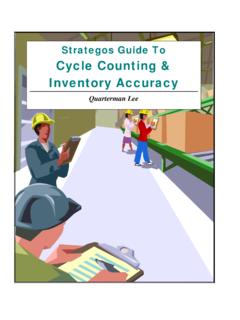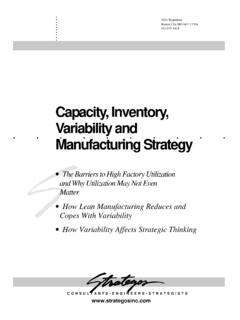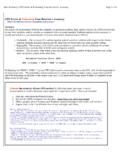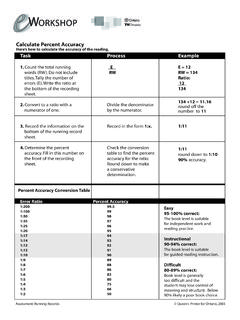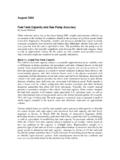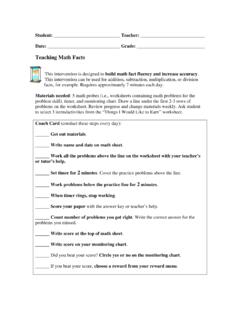Transcription of Cycle Counting & Inventory Record . . . . . . . . . …
1 Cycle Counting & Inventory Record accuracy There s More To Cycle Counting Than Counting Strategos, Inc. 3916 Wyandotte Kansas City, MO 64111 816-931-1414 CONS UL T ANT S E NGI NE E RS ST RAT E GI ST S.. 2 Cycle Counting & Inventory Record accuracy There s More To Cycle Counting Than Counting Inventory accuracy What Is Inventory Record accuracy ? Inventory Record accuracy (IRA) is a measure of how closely official Inventory records match the physical Inventory . Many managers equate IRA with Cycle Counting , but there is a lot more to Inventory accuracy than just Counting . The units of measurement for accuracy are either dollar based or count based. These two bases have different purposes and may give widely differing results. Accountants and financial auditors prefer dollar-based measurements. Their concern is to ensure that the Inventory value stated on books and tax returns is accurate at an aggregate level.
2 Discrepancies on individual items hold little concern provided that positive and negative discrepancies are roughly equal and the total value is the same. Operations and material management people have a stronger interest in the accuracy of individual SKUs. If one SKU is short, they can rarely substitute some other part or item that happens to be long. Why Is It Important? The reasons for having accurate records are legion. Here are a few of them: Financial Reasons: Investors want to know that the book value is accurate. Lenders who loan money with Inventory as collateral want to protect their loan. Taxation often depends on Inventory value. Overpayment of taxes reduces profits and underpayment can incur severe penalties. Poor accuracy begets more Inventory and requires more capital. Inventory is often the largest consumer of capital for an enterprise.
3 Operational Reasons: Stockouts interrupt production and create delivery delays. People waste hours looking for misplaced or missing items. When stockouts are frequent, Inventory rises in an attempt to compensate. This unnecessary Inventory requires space and capital. Stockouts increase cost in a hundred ways and sap the time and energy of everyone.. 3 Inventory turnover reflects overall manufacturing efficacy. MRP and ERP systems require very high accuracies (95%-99%) to function well. IRA & Lean Manufacturing Lean Manufacturing reduces the need for Inventory and transaction volume. It makes high accuracy easier. However, this takes many years and Inventory will be with us for a long time. The stockouts common to firms with poor accuracy generate significant fears throughout the organization and create complications for a lean implementation.
4 Because of this, increasing Inventory accuracy may be a necessary part of a lean manufacturing strategy. Reasons For Inaccuracy There are many causes for inaccurate records. People may enter data inaccurately or not at all. Confusing location codes cause discrepancies between recorded and actual locations. Occasionally, software bugs introduce errors. The thousands of possible causes are either process-related or volume-related. Process Related Errors Each step in a transaction process introduces some probability for error, even if that probability is small. To reduce process-related errors, we must change the process. Volume-Related Errors Every transaction process has an inherent error rate resulting from the process. Over time, and with many transactions, the number of new errors per week or per thousand transactions is relatively constant, if the process remains unchanged.
5 The more transactions, the more errors. If transaction volume is reduced through kanban, backflushing, Cellular Manufacturing or other simplification, errors drop proportionately. Methods For Improving accuracy To improve Inventory Record accuracy , the error creation rate ( errors per week, month, etc.) must be less than the error removal rate. to increase accuracy we can decrease errors flowing in or increase the removal rate. Methods to improve accuracy include Cycle Counting , Physical Inventory , Transaction Reduction and Process Improvement. An optimal approach may use them all. Figure 1 Inventory Error Rates Physical Inventory In a physical Inventory , normal operations cease while a physical count of every item is conducted. The counts are compared to Inventory records and, when necessary, the records are corrected. Cycle Counting A small number of items are physically counted, daily, on a random or semi-random basis.
6 The physical count is compared to the Inventory Record . When necessary, the records are corrected. Process Improvement Process Improvement examines the transaction processes. Changes are identified that reduce the probability of error. Transaction Reduction An effective way to reduce errors is to reduce the number of transactions. Fewer transactions introduce fewer errors. Kanban, BOM simplification, cellular manufacturing and other elements of Lean make this feasible. Current InventoryRecordsTransactions &Errors InTransactionsOutErrorsOutCurrent Errors.. 4 Cycle Counting What Is Cycle Counting ? Cycle Counting finds and corrects Inventory Record errors. Cycle counters select a small sample of Inventory items for audit each day. The selection is random or semi-random. When they find errors, they immediately correct them. Cycle Counting removes errors from the system, much like a physical Inventory , but has significant advantages.
7 Cycle Counting Achieve Very High Accuracies Level the Workload Reduce Inventory Continuously Measure Inventory accuracy Function without Interruption of Operations Facilitate Process Improvement Eliminate The Annual Inventory Audit Figure 2 Statistical sampling Cycle Counting Example Cycle Counting uses the principle of statistical inference, just as in opinion polling. In figure 2, we take a random sample of 100 beans out of the "population" of 3000 beans. If 20% of those beans are red, it infers that 20% (600) of the population is also red. Imagine each bean is a different Inventory item and the red beans are items with erroneous records. If we Cycle count 100 items (beans) and correct any errors in the records, we have estimated the accuracy of our Inventory records (80%) and removed 20 errors. Repeated over time, the process measures and improves Inventory Record accuracy provided that errors are removed faster than they are being introduced.
8 A running chart, as shown in figure 4, thus shows whether the weekly volume of Cycle counts is adequate. Population=3000 BeansSample=100 Beans20 Red80 White80%20%80%20% 5 Estimating the number of counts required each week and the staffing required to do them is always an issue when starting a new program. We address this in our training program, " Cycle Counting and Physical Inventories." Figure 3 Cycle Counting Example Figure 3 shows the results of a typical Cycle Counting program. IRA percentages in the first five weeks showed an accuracy of about 52%. As the program removed errors from the system, accuracy increased to about 96% by week 28. The drop in accuracy from week 28 through week 35 indicates some change in the system. `Fewer counts, perhaps, or volume may have increased or new employees may have introduced more errors.
9 Corrective action was taken about week 36 and accuracy rose again until about week 40. From week 40 through week 52 the system is stable at about 93%. To improve further, the organization must reduce the input error rate, reduce transaction volume or increase the number of weekly Cycle counts. Improving Count Effectiveness Cycle Counting can require large efforts, especially when IRA is in the 90%+ range. To improve error detection and reduce the number of counts required, several techniques are available. Segregate By ABC A-B-C classification applies to Cycle Counting as well as to other areas of Inventory management. The highest cost and most important items (A-Items) get counted most often. Zone The Counts this technique groups daily counts into the same zone or area to reduce travel time for the counters. Zero on Book Condition This guarantees either a fast count or an error discovery.
10 Zero on Shelf Condition Another guaranteed fast count or error discovery. Negative Balance A guaranteed error discovery.. 6 Hazards In Cycle Counting Insufficient Staffing This usually results from underestimating the number of counts required when the program is initially developed. Diversion of Effort To the rest of the organization, Cycle Counting does not seem to accomplish much of immediate importance. Cycle counters become a convenient source of staff for all sorts of odd jobs that arise. Over time the practice of borrowing Cycle counters dilutes the effort and reinforces the perception of non-accomplishment. Ignoring Error Creation Error prevention is always more productive than correction. Some systems create errors so fast that it is impractical to Cycle count enough for high accuracy . Insufficient Training Cycle counters need training on Counting properly and also on resolving discrepancies.
